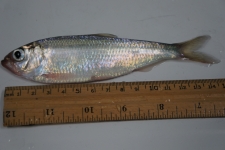If you’ve ever reeled in a king salmon from the Great Lakes, thank a scientist.
It’s hard to gaze out over Lake Erie and imagine anyone managing that vast silvery expanse of water. Yet Lake Erie, along with the other four Great Lakes of North America, are managed by government agencies. Because Lakes Superior, Huron, Erie, and Ontario are bordered by both the United States and Canada, the agencies represent two federal governments and many state and provincial governments.
Agencies work closely with scientists who do the research and collect much of the data used by the Great Lakes managers. “Good management depends on good science,” said Randal Snyder, an ichthyologist and professor of biology at Buffalo State. Snyder recently received a continuing grant for $18,000 from the University of Illinois to carry on his research on alewives, a fish species he has studied for more than 15 years.
“Alewives are fascinating,” he said. “They are a marine [ocean] fish that has adapted completely and successfully to life in fresh water.” One goal of the grant is to learn more about alewives to better manage fisheries in the Great Lakes.
Focus on Fisheries
“A fishery,” Snyder explained, “refers to all the stakeholders—the public, industry, the government, and scientists—involved in a particular species of aquatic animal. In the ocean, you have oyster fisheries and lobster fisheries, so a fishery doesn’t even have to be about fish.” Fish with no economic value or those that are endangered—say, lake sturgeon, which have almost disappeared from the Great Lakes—can’t be said to constitute a fishery because they aren’t harvested. Great Lakes fisheries include the alewife fishery (alewives are harvested for fish meal) and the salmon fishery, an important recreational fishery.
“In the Great Lakes, the agencies work together, dividing up responsibilities so they don’t duplicate efforts,” said Snyder. “Basin-wide issues, such as the threat posed by Asian carp, may be managed by federal agencies because it affects all the Great Lakes, but usually state agencies oversee the recreational fishing industry.”
To manage fisheries successfully, agencies rely on scientific data. “Managers need to know how many fish of a particular species there are,” said Snyder. “And they need to know if that number is growing or shrinking, and why.”
Scientists such as Snyder may monitor fish species by taking samples and using mathematical models to predict the status of various species. “If we sample the same location in the same way over a period of years,” said Snyder, “we have some really valuable information, and we can spot trends.”
If a species seems to be decreasing, managers might regulate the numbers of fish that can be caught, or increase the number of fish stocked in the lake from hatcheries. New York State’s Department of Environmental Conservation has 12 hatcheries, which produce several varieties of trout and salmon as well as other species.
Alewives Adapt
However, alewives are a very adaptable species. Once they gained access to the Great Lakes, after the Erie and Welland Canals were built in the nineteenth century, alewives flourished in fresh water. By the 1950s, alewives (a kind of herring) were so widespread that they crowded out native Great Lakes herring species.
“What’s good about alewives in the Great Lakes is that they provide food for salmon and trout,” said Snyder. Recreational fishing for coho and king salmon, both introduced species, has become a significant economic activity in the Great Lakes.
However, salmon appear to be among the relatively few fish that can safely eat alewives. The problem, Snyder explained, is that alewives have an enzyme, thiaminase. Fish that feed on alewives consume the thiaminase, which breaks down vitamin B in most fish and causes a vitamin deficiency that interferes with normal reproduction.
“Scientific research uncovered the vitamin B deficiency and its connection to alewives,” said Snyder.
A Genetic Switch?
The grant will support Snyder’s research, including his work at the Great Lakes Center Field Station on Buffalo’s waterfront. Snyder has achieved expertise in keeping alewives alive under laboratory conditions. “For all their adaptability,” he said, “they don’t tolerate captivity well.” His tanks include alewives from Maine and the Finger Lakes so that freshwater and marine alewives can be compared.
“The new twist in the study this year is investigating the genetics of alewives as a model for invasive species,” said Snyder. “The geneticist I am working with, Dr. Pawel Michalak at the Virginia Bioinformatics Institute, will try to understand how alewives adapt genetically to conditions so different from their native habitats. The hope is that we’ll be able to identify a few key genes that switch on and off to enable a marine fish to thrive in the Great Lakes.”
Such new knowledge may put additional tools in the hands of Great Lakes managers, helping to sustain the Great Lakes ecosystem and the agricultural, tourist, and manufacturing industries as well as the 30 million human beings who depend on it for drinking water.
